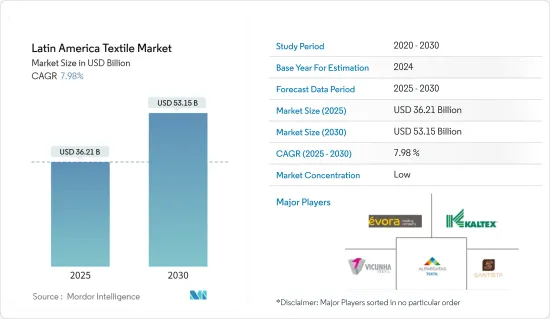PUBLISHER: Mordor Intelligence | PRODUCT CODE: 1642107

PUBLISHER: Mordor Intelligence | PRODUCT CODE: 1642107
Latin America Textile - Market Share Analysis, Industry Trends & Statistics, Growth Forecasts (2025 - 2030)
The Latin America Textile Market size is estimated at USD 36.21 billion in 2025, and is expected to reach USD 53.15 billion by 2030, at a CAGR of 7.98% during the forecast period (2025-2030).

A diverse and vibrant industry with solid roots in traditional craftsmanship and a growing presence in the global fashion and home textiles sectors characterize the Latin American textiles market. The region benefits from an abundance of natural resources, including cotton and wool, which are integral to textile production. Key markets such as Brazil, Mexico, and Colombia are leading in manufacturing and export activities, while countries like Peru and Guatemala are renowned for their high-quality, artisanal textiles.
The market is witnessing growth due to increasing demand for sustainable and ethically produced textiles, driven by a global shift toward eco-friendly products. Additionally, technological advancements in textile manufacturing and a rise in e-commerce are further propelling the industry's expansion. However, the market also faces challenges, such as competition from low-cost producers in Asia and economic fluctuations within the region.
Latin America Textile Market Trends
Rise in the Clothing Industry is Fueling the Market
The clothing industry is a significant driver of the Latin American textile market, fueling growth and innovation across the region. With a strong tradition of textile production, countries like Brazil, Mexico, and Colombia are at the forefront of manufacturing apparel for domestic and international markets. The region's clothing industry is benefiting from increasing consumer demand for fashion, including a rising interest in locally made, sustainable, and ethically produced garments. Latin America's proximity to major consumer markets in North America also enhances its competitive edge, allowing for quicker turnaround times and lower transportation costs compared to Asian producers.
Additionally, the growth of fast fashion and the expansion of e-commerce platforms are accelerating the demand for textiles in the clothing sector. Local designers and brands are gaining recognition, boosting the industry's appeal. However, challenges remain, including competition from global apparel manufacturers and the need for investment in modernizing production facilities to meet international standards. Despite these obstacles, the clothing industry continues to be a pivotal force in driving the market forward.
Rising Cotton Production is Driving the Market's Growth
Increasing cotton production is crucial to the growth of the Latin American textile market. Countries including Brazil, Argentina, and Mexico are among the region's leading cotton producers, contributing significantly to the textile industry's supply chain. Brazil, in particular, has emerged as one of the world's top cotton exporters, with advancements in agricultural technology and sustainable farming practices boosting its production capacity.
The rise in cotton production supports the domestic textile industry by providing a reliable and high-quality raw material source, reducing dependency on imports, and enhancing the competitiveness of Latin American textiles on the global stage. This increase in local cotton availability also supports the growth of the clothing and home textiles sectors, which rely heavily on cotton fabrics.
Latin America Textile Industry Overview
The Latin American textiles market is semi-fragmented, with many players. The market is strong in countries like Peru, Guatemala, and Colombia, where traditional and artisanal textile production is prevalent. These smaller players focus on niche markets, such as handcrafted and culturally significant textiles, which contribute to the market's diversity. The key players include Evora SA, Kaltex SA, Vicunha Textil SA, Alpargatas SAIC, and Santista Argentina SA.
Additional Benefits:
- The market estimate (ME) sheet in Excel format
- 3 months of analyst support
TABLE OF CONTENTS
1 INTRODUCTION
- 1.1 Study Assumptions and Market Definition
- 1.2 Scope of the Study
2 RESEARCH METHODOLOGY
3 EXECUTIVE SUMMARY
4 MARKET INSIGHTS AND DYNAMICS
- 4.1 Market Overview
- 4.2 Market Drivers
- 4.2.1 Increasing Demand for Sustainable and Locally Produced Textiles
- 4.2.2 Strong Tradition of Textile Craftsmanship
- 4.3 Market Restraints
- 4.3.1 Economic Instability and Fluctuations in Currency Exchange Rates
- 4.4 Market Opportunities
- 4.4.1 Increasing Demand for Sustainable Products
- 4.4.2 Expansion of E-commerce
- 4.5 Value Chain/Supply Chain Analysis
- 4.6 Porter's Five Forces Analysis
- 4.6.1 Threat of New Entrants
- 4.6.2 Bargaining Power of Buyers/Consumers
- 4.6.3 Bargaining Power of Suppliers
- 4.6.4 Threat of Substitute Products
- 4.6.5 Intensity of Competitive Rivalry
- 4.7 Technological Innovation in the Industry
- 4.8 Impact of the COVID-19 Pandemic on the Latin America Textiles Market
5 MARKET SEGMENTATION
- 5.1 By Application
- 5.1.1 Clothing
- 5.1.2 Industrial/Technical Applications
- 5.1.3 Household Applications
- 5.2 By Material
- 5.2.1 Cotton
- 5.2.2 Jute
- 5.2.3 Silk
- 5.2.4 Synthetics
- 5.2.5 Wool
- 5.3 By Process
- 5.3.1 Woven
- 5.3.2 Non-woven
6 COMPETITIVE LANDSCAPE
- 6.1 Market Competition Overview
- 6.2 Company Profiles
- 6.2.1 Evora SA
- 6.2.2 Kaltex SA
- 6.2.3 Vicunha Textil SA
- 6.2.4 Coteminas SA
- 6.2.5 Alpargatas SAIC
- 6.2.6 Santista Argentina SA
- 6.2.7 Santana Textiles SA
- 6.2.8 Fabricato SA
- 6.2.9 Pettenati SA Textile Industry
- 6.2.10 Australtex SA*
7 FUTURE MARKET TRENDS
8 DISCLAIMER AND ABOUT US




